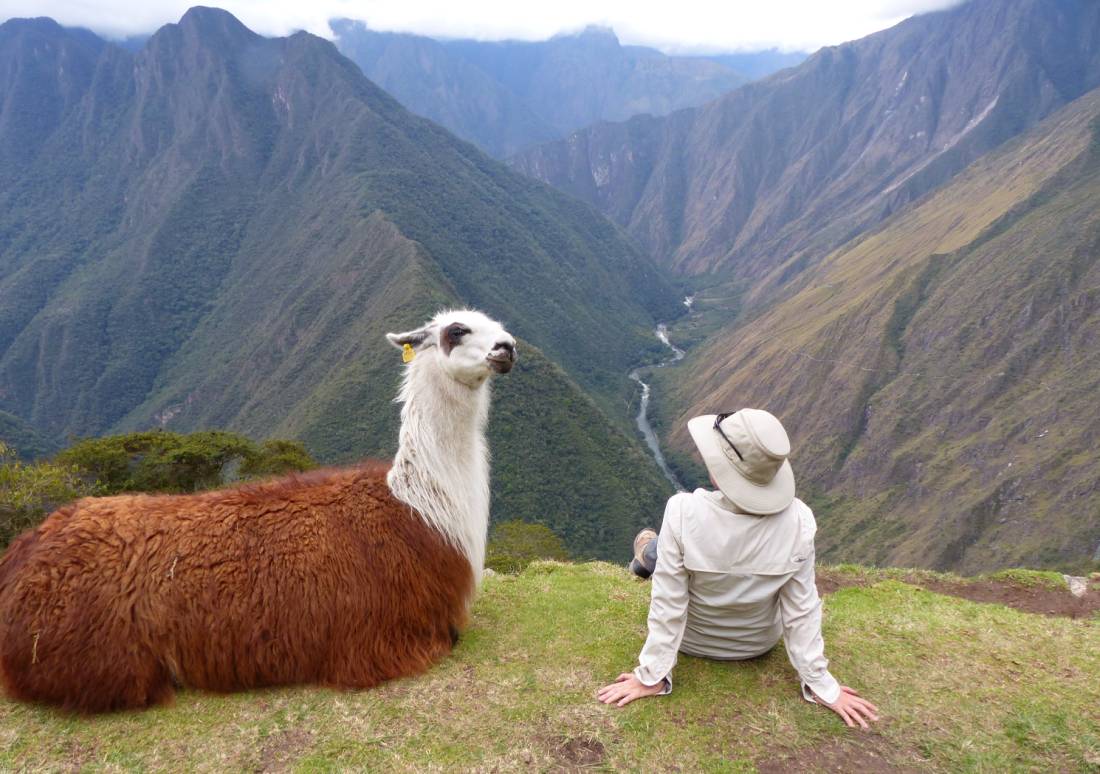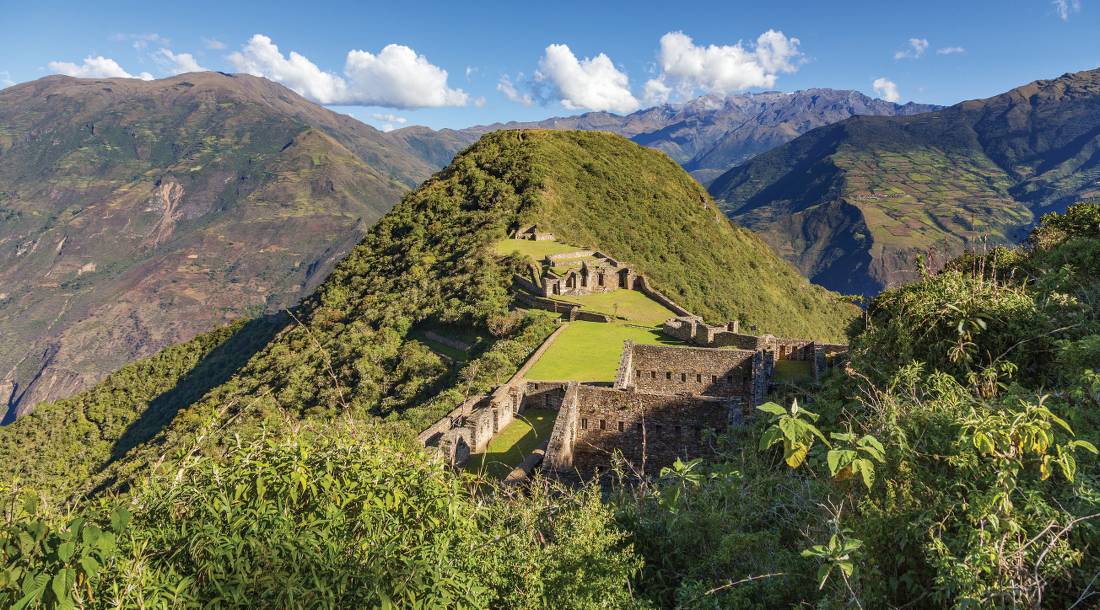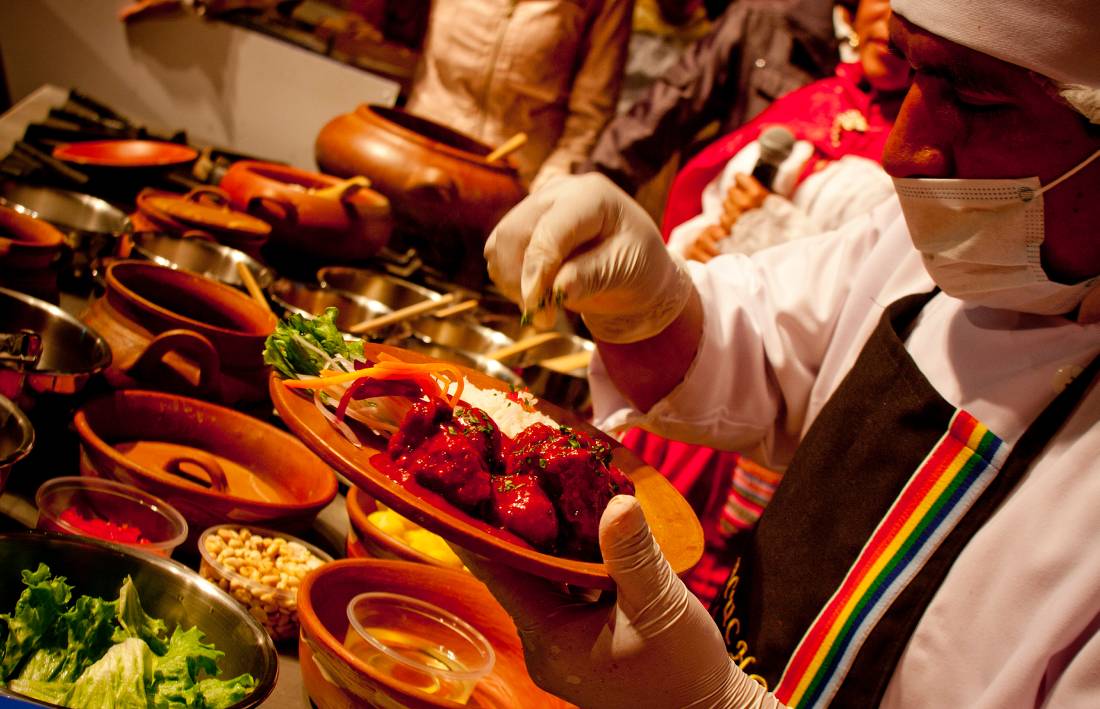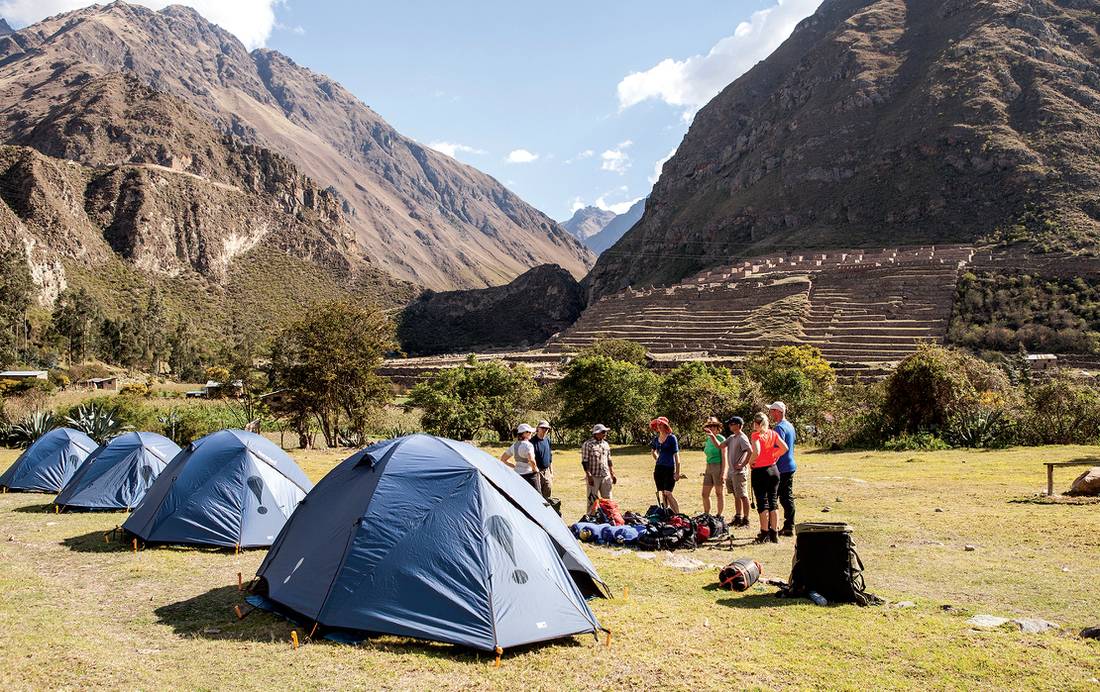The Inca Trail to Machu Picchu has been coined in many guidebooks as the ‘best short trek in the world’ and with a bit of training, almost anyone can walk the Inca Trail, but only with a permit.
Specialising in high-quality treks along the Inca Trail and to Machu Picchu for more than three decades, here’s everything you need to know about hiking the Inca Trail, with bonus tips from our adventure experts.
Jump to a section:
How difficult is it to walk the Inca Trail? What is the terrain like?
How can I prepare for the trek?
How many hours a day do you walk?
How can I avoid altitude sickness?
Can I walk the Inca Trail myself? How can I get a permit?
Why do I need a permit?
What if I can't get a permit?
Can I visit the Sun Gate without having to hike the Inca Trail?
I want to visit Machu Picchu but want to try a different trek to the classic Inca Trail. What are some alternatives?
When is the best time to walk the Inca Trail?
What climates can I expect?
What gear should I bring with me?
How much time can I spend at the Machu Picchu sanctuary?
What can I do at the Machu Picchu sanctuary?
What can’t be brought into the Machu Picchu sanctuary?
What will I eat along the trail?
What is the accommodation like?
How does World Expeditions do the Inca Trail differently?
Which trail should I choose?
How difficult is it to walk the Inca Trail? What is the terrain like?
It’s not our most challenging trek, but you will be walking over hilly and rugged terrain with lots of stairs.
Expect some long, steep ascents too. Most of the walking is on fairly well-defined tracks, including some remarkable sections of ancient Inca stone "highways". There are some river crossings but no sections where scrambling is involved. It is recommended that you stay on the stone path at all times and keep well away from the edge.
With the help of porters carrying your personal gear, you’ll only need to worry about carrying a day pack of around 5-8kg including your water, camera and clothing layers.
RELATED ARTICLE: How hard is it to hike the Inca Trail?
How can I prepare for the Inca Trail trek?
The more training you do beforehand, the more you will enjoy your trek. We recommend 30 minutes of cardio activities 3-4 times a week in the 2-3 months leading up to your departure. Take every opportunity to walk up and down stairs or hills for leg strengthening and aerobic fitness.

How many hours a day do you walk on the Inca Trail?
The trekking day very much depends on the condition of the trails, the weather and the fitness of the group but expect to walk for 6-7 hours a day.
The morning's walk usually lasts from about 8 am to 12.30 pm and allows for numerous rest and photo stops. After a post-lunch siesta, we set off for the afternoon's hike – usually 2-3 hours to the camp.
How can I avoid altitude sickness on the Inca Trail?
Altitude is also an important factor to consider, with the highest point of the trail at 4200 metres. The effects of altitude sickness can vary for different individuals, but some key things to keep in mind is to take it easy and ascend slowly.
Staff tip: Have plenty of fluids – hydration is so important when acclimatising.
Our itinerary is very well-paced to ensure you acclimatise safely – so ideal for first-timers, where you’ll walk through impressive Inca sites of the Sacred Valley before undertaking the Inca Trail trek.
Can I walk the Inca Trail myself? How can I get a permit?
No, you need a permit to walk the Inca Trail. Only approved tour operators, like World Expeditions, can obtain a permit.
Joining a small group to travel with a licensed operator means you can experience the comfort, seamless organisation and security of an active holiday. World Expeditions have all necessities taken care of, including hearty meals prepared by trained cooks, quality two-person tents erected in scenic wilderness, a lighter pack thanks to our team of porters, as well as the use of a sleeping bag, Thermarest and fibre-filled jacket.
Not to mention, having an expert bilingual guide adds to the experience as they share the history of the Incan empire and sites you visit, with their own tales of fascinating cultural and travel experiences.
Why do I need an Inca Trail permit?
Machu Picchu stands much the same as it did hundreds of years ago due to its superior architecture and carefully managed conservation programs. To protect Machu Picchu from the impact of its popularity, Peruvian authorities have implemented entry restrictions where only 500 permits are issued each day to walk the Inca Trail into Machu Picchu.
By the time permits are issued to porters, guides and other support staff, this leaves a limited amount of permits available for trekkers. Permits always sell out in high season, so it is highly recommended to book months in advance to secure a permit.
What if I can't get an Inca Trail permit?
If you miss out on a permit, World Expeditions has developed several brilliant Inca Trail alternatives to ensure you can experience the magic of trekking through the Andes and the Sacred Valley of the Incas to behold the wondrous Machu Picchu as the finale.
Travellers can still book on our Inca Trail itineraries but if Inca Permits are sold out already, we offer the Salcantay trek instead at no additional cost on many of our Inca Trail trips.
Can I visit the Sun Gate without having to hike the Inca Trail?
Yes, everyone who has an entrance ticket for Machu Picchu can walk up to the Inti Punku 'Sun Gate', which is approximately a 45-minute walk.
Staff tip: It’s important to note that to make it to the Sun Gate for the sunrise you must first have to catch a bus, queue to get into Machu Picchu and then walk about 45 minutes.
I want to visit Machu Picchu but want to try a different trek to the classic Inca Trail. What are some alternatives?
The classic Inca Trail is a quintessential Peruvian trek, however, hiking this iconic route is not the only way to get to Machu Picchu.
There are other treks you can hike that are no less spectacular, including the alternate Salcantay trek, with a scenic train journey to Machu Picchu town after the trek; or choose the Salcantay Base Camp trek which joins the classic Inca Trail on the final day.
A particular staff favourite is the Inca Rivers Trek from Choquequirao to Machu Picchu that take you to rare and incredible views of Machu Picchu. This is a more remote trek, which is moderate to challenging, but offers a more varied trail away from the crowds to other spectacular Inca Ruin sites, such as Choquequirao, through the sublime Vilcabamba mountain range and between two sacred Inca Rivers.

When is the best time to walk the Inca Trail?
The main trekking season in Peru lasts from late April to mid-October. This is the dry but 'cold' period, with the best mountain views and all passes open.
What climates can I expect on the Inca Trail?
Variance in latitude, elevation and local winds all factor into the wide range of climates experienced in the central Sierra/Andean mountain region. Average temperatures in the Sierra vary little between seasons, but there is dramatic daily variance.
While the average daily temperature may only vary a few degrees Celsius between January and July, the diurnal (daily) temperature range is often huge. You can expect daytime temperatures in the highlands to be in the range of 10-25°C (50-77 °F), falling as low as -10 °C (14°F) at night.
What gear should I bring with me on the Inca Trail?
Essential trekking gear includes merino socks (add in some extras), an anti-blister kit, warm clothes, waterproofs, worn-in boots, sunglasses, sunscreen, camera and trekking poles.
We provide a comprehensive gear list as part of our traveller’s pre-departure kit and gear such as sleeping mats, sleeping bags and a fibre-filled jacket are available for use for trekkers.
How much time can I spend at the Machu Picchu sanctuary?
There are three time slots in which patrons can enter Machu Picchu for a maximum of four hours and must follow one of three predetermined routes. Admission is not allowed after 4pm. Additionally, all visitors must always be accompanied by a guide.
To ensure you get the most of your Machu Picchu experience regardless of these restrictions, most of our Inca Trail trips include an extra visit to Machu Picchu, with an overnight stay in Aguas Calientes, to fully appreciate this new world wonder.
Staff tip: The early morning is one of the best times to savour the views and atmosphere of Machu Picchu. The mystical morning light over the enigmatic sites is spectacular. Try and catch the sunrise at the sanctuary, you won’t regret the early wake-up call!
What can I do at the Machu Picchu sanctuary?
On many of our Inca Trail trips, travellers are treated to a unique second visit to Machu Picchu, which includes a tour by a local guide in this colossal sanctuary.
Your guide will take you through the different sectors, bringing alive the history and stories of these ancient and iconic ruins. You’ll feel like you’re taking a step back in time as you soak up the astonishing views, expert knowledge, and impressive ruins.
For the more adventurous, you can climb one of the two mountains in the Machu Picchu sanctuary by purchasing a Huayna Picchu or Machu Picchu Mountain permit and forego the guided tour of Machu Picchu.
Both climbs are a minimum of three hours return and are very steep, with many small and narrow steps, and can be slippery and are very exposed with vertiginous drops.
What can’t be brought into the Machu Picchu sanctuary?
The following items are prohibited in Machu Picchu: drones, selfie sticks, tripods for cameras, walking sticks without rubber tips, backpacks that exceed 40cm x 35cm x 20cm, aerosol spray, sharp objects, banners or posters.
As of December 2018, single-use plastic bottles and any other single-use plastics (bags, cups, straws, etc) are prohibited in the sanctuary, on the Inca Trail and all other protected natural areas in Peru. This regulation was established by the Ministry of Environment, following the Sustainable Tourism Regulation which aims to conserve these protected natural areas. Please ensure to bring your reusable water bottle on all our Peru trips.
Water refill stations have been installed in areas near Machu Picchu and other national parks. Your guide will brief you on where you can refill your water bottles with drinking water.
What will I eat along the Inca Trail?
We provide a full service while on the trek, including three hearty meals a day. Typically, you can expect breakfast to consist of muesli or cereal, eggs, local bread and pancakes and hot drinks.

Lunch will generally be vegetables, salads, bread, cheese pasta style dishes, tinned fish and meats and are normally eaten picnic style. Dinner is always three courses and includes soup, seasonal vegetables, meat, rice or pasta and bread with some local specialities also in the mix. All evening meals are followed by desserts and hot beverages, of course!
Our cooks are trained to provide excellent food for vegetarians and anyone who has a limited diet including those who are lactose or gluten intolerant.
What is the accommodation like on the Inca Trail trek?
In cities or large towns, you will be accommodated in three to four-star properties that are centrally located, atmospheric and commodious. In smaller towns and villages hotel options are often limited with more basic accommodation used, however you can be assured of clean, comfortable and well-located lodgings.

During the trekking section, enjoy our fully supported camping experience in quality two-person tents with plenty of personal space and storage for your luggage. Our team are on hand to ensure your comfort and safety with a dining tent, a separate cooking tent and where appropriate, a toilet tent is erected.
How does World Expeditions do the Inca Trail differently?
• The Classic Inca Trail trek ensures you are well acclimatised to the altitude with day walks through impressive Inca sites of the Sacred Valley before the Inca Trail trek. With at least 2 or more days of acclimatisation built into all our itineraries before the start of the Inca Trail, the high passes and altitude experience on the trek will be easier to conquer.
• Enjoy fully supported camping with gear included! Each trekker is equipped with a kit bag which includes a sleeping bag, inflatable sleeping mat and fibre-filled jacket.
• To appreciate the majestic ruins of Machu Picchu, an extra visit to the famous sanctuary is also included.
• We tread lightly and thoughtfully in the places we visit for minimal environmental impact. We have a zero-litter policy, utilise an eco toilet system at our campsites, and have innovative schemes to reduce waste on the trek, including our 10 Pieces waste collection program.
Which Inca Trail trip should I choose?
Jungle trails, cloud forests and panoramic views of Andean peaks will inspire you as you follow in the footsteps of the Incas on your way to Machu Picchu. The only question now is, which trip should you take? View our complete list of Inca Trail and Machu Picchu adventures >